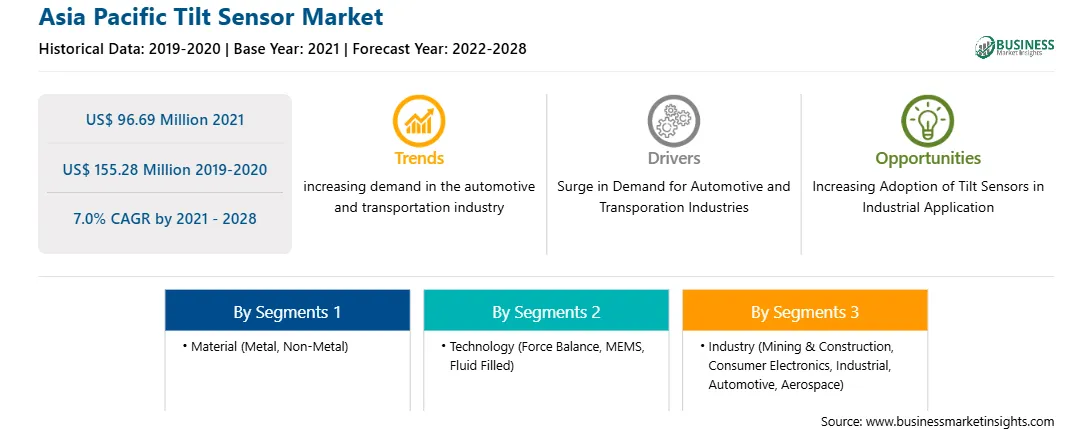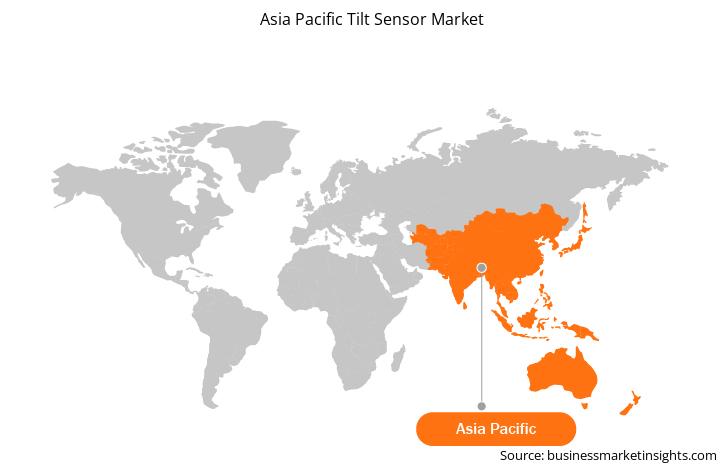2028 年亚太倾斜传感器市场预测 - COVID-19 影响和区域分析,按材料(金属和非金属)、技术(力平衡、MEMS 和流体填充)和行业(采矿和建筑、消费电子、工业、汽车、航空航天等)
No. of Pages: 128 | Report Code: TIPRE00027726 | Category: Electronics and Semiconductor
No. of Pages: 128 | Report Code: TIPRE00027726 | Category: Electronics and Semiconductor
促进市场增长的关键因素是< /span>倾斜传感器在工业应用中的应用不断增长,以及建筑设备的需求激增。然而,基于力平衡技术的倾斜传感器的高成本可能会阻碍预测期内的市场增长。
工业机器人如今应用于各个行业,包括半导体和汽车,以及塑料加工和金属锻造。几乎所有重复性任务,尤其是对人类来说有风险或困难的任务,都是机器人的理想选择。机器人在制造业中的使用尤其有益。传统上,它们被用于大批量活动,但随着技术的进步和工业机器人成本的下降,中小型操作的更多选择和机会正在变得可用。
当与工业物联网 (IIoT) 或 3D 打印机器人等其他技术相结合时,工业机器人可以提供更高的产品质量和更精确、更可靠的流程。其他附加好处包括缩短周期持续时间和实时监控,以实现更好的预防性维护程序。工业机器人每周 7 天、每天 24 小时运行,加快了制造运营的步伐。机器人不需要休息和换班。
机器人的速度和可靠性有助于缩短周期时间并提高吞吐量。当机器人执行重复性工作时,工人受伤的可能性较小,这在恶劣环境下进行生产时尤其重要。主管还可以在线或远程远程监控整个过程。让一个人监督许多生产任务通常比使用机器人更昂贵。然后,员工的才能和知识可以应用于其他组织部门,例如工程、编程和维护。倾斜传感器用于测量机器人中与地平面参考的倾斜角度。这种类型的传感器用于工业、服务机器人和其他领域,例如手机、游戏和飞机。即使机器人用腿或轮子移动,也必须每秒多次测量倾斜度,以使机器人保持其位置。倾斜传感器使用一轴、两轴或三轴测量趋势,其精度因传感器而异。温度、重力、振动、冲击、加速/减速和各种其他噪声类型都会影响精度。
COVID-19 的爆发给企业带来了巨大的经济损失。亚太地区。亚太国家政府采取了几项关键措施,通过实施封锁和物理距离规范来遏制病毒的传播,这对制造业产生了负面影响。中国拥有数量众多的电子和半导体制造业,众多制造商在全球运营和支持多个行业。
中国倾斜传感器市场参与者已经观察到对各自领域的巨大影响。 2020 年第一季度的业务下滑,反映出收入大幅下降,导致中国和亚太地区倾斜传感器市场出现亏损。此外,中国的传感器系统制造商数量也明显较多。中国政府在第一季度实施的封锁措施和物理距离规范反映了传感器系统供应量的大幅下降,最终导致倾斜传感器市场的收入大幅下降。
在这个充满挑战的时期,建设比以往任何时候都更加重要。该行业在应对危机和复苏过程中发挥了至关重要的作用,从在几天内建立医院到提供救生设备。建筑业占全球 GDP 的 13%,在解决最紧迫的建筑相关需求的同时增加劳动力供应可能有助于推动复苏。然而,建筑业却遭受重创,许多国家的建筑工地纷纷关闭。大多数开放地点都经历了供应链中断和运营限制。金融指数反映了这种破坏:自 2021 年以来,公共工程、建筑和建筑材料 (ECB) 业务的跌幅远超平均水平。此外,大流行导致的社会疏远规范增加了各行业机器人的使用,传感器作为重要组成部分。这些因素预计将支撑亚太地区的倾斜传感器市场。
亚太地区倾斜传感器市场细分
Strategic insights for Asia Pacific Tilt Sensor involve closely monitoring industry trends, consumer behaviours, and competitor actions to identify opportunities for growth. By leveraging data analytics, businesses can anticipate market shifts and make informed decisions that align with evolving customer needs. Understanding these dynamics helps companies adjust their strategies proactively, enhance customer engagement, and strengthen their competitive edge. Building strong relationships with stakeholders and staying agile in response to changes ensures long-term success in any market.

| Report Attribute | Details |
|---|---|
| Market size in 2021 | US$ 96.69 Million |
| Market Size by 2028 | US$ 155.28 Million |
| Global CAGR (2021 - 2028) | 7.0% |
| Historical Data | 2019-2020 |
| Forecast period | 2022-2028 |
| Segments Covered |
By 材质
|
| Regions and Countries Covered | 亚太地区
|
| Market leaders and key company profiles |
The regional scope of Asia Pacific Tilt Sensor refers to the geographical area in which a business operates and competes. Understanding regional nuances, such as local consumer preferences, economic conditions, and regulatory environments, is crucial for tailoring strategies to specific markets. Businesses can expand their reach by identifying underserved regions or adapting their offerings to meet regional demands. A clear regional focus allows for more effective resource allocation, targeted marketing, and better positioning against local competitors, ultimately driving growth in those specific areas.

The Asia Pacific Tilt Sensor Market is valued at US$ 96.69 Million in 2021, it is projected to reach US$ 155.28 Million by 2028.
As per our report Asia Pacific Tilt Sensor Market, the market size is valued at US$ 96.69 Million in 2021, projecting it to reach US$ 155.28 Million by 2028. This translates to a CAGR of approximately 7.0% during the forecast period.
The Asia Pacific Tilt Sensor Market report typically cover these key segments-
The historic period, base year, and forecast period can vary slightly depending on the specific market research report. However, for the Asia Pacific Tilt Sensor Market report:
The Asia Pacific Tilt Sensor Market is populated by several key players, each contributing to its growth and innovation. Some of the major players include:
The Asia Pacific Tilt Sensor Market report is valuable for diverse stakeholders, including:
Essentially, anyone involved in or considering involvement in the Asia Pacific Tilt Sensor Market value chain can benefit from the information contained in a comprehensive market report.